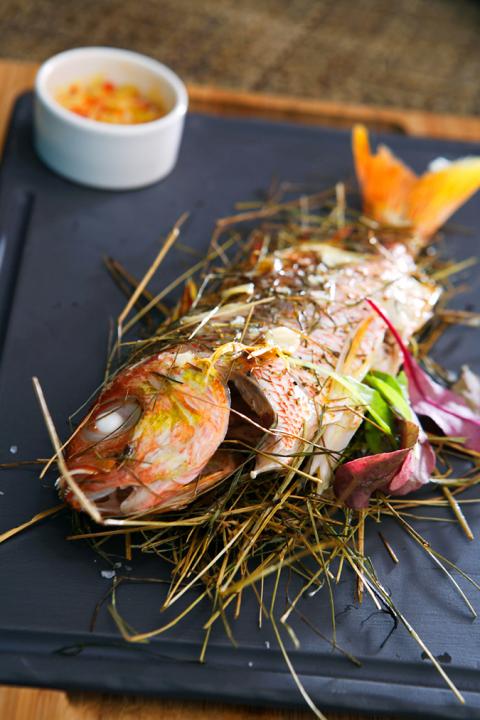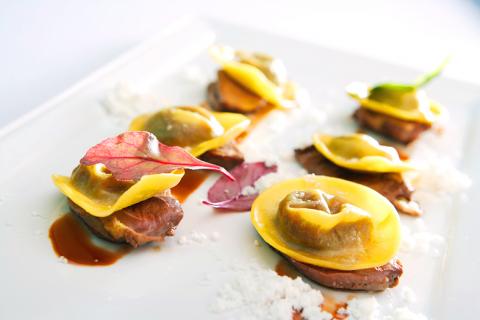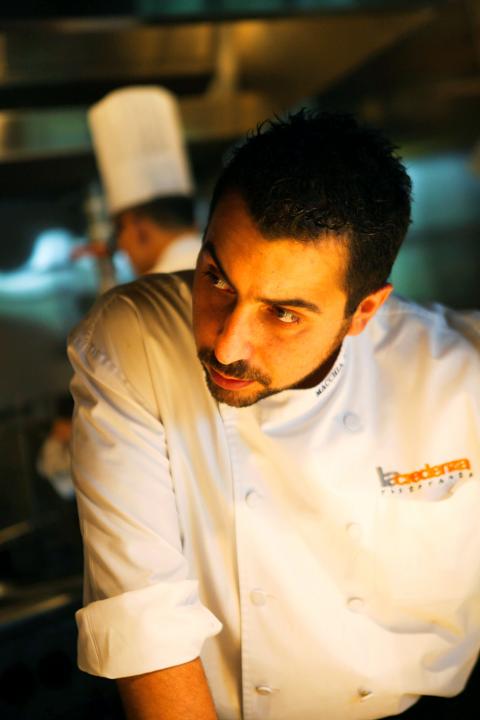Michelin-starred chefs are pouring into Taiwan these days, and increasingly they are doing more than just popping into town on a consultant gig or for a couple of weeks as a guest chef. Following the path pioneered with the opening of L’Atelier de Joel Robuchon at the swank Taipei Bellavita mall in 2009, Igor Macchia, chef and owner of the one-Michelin-star La Credenza in Italy, is in Taiwan to supervise the opening of La Festa at the Grand Victoria Hotel (維多麗亞酒店).
La Festa is the first Italian restaurant opened by a Michelin-starred chef in Taiwan. It is a chance for Taiwanese to enjoy the very best of contemporary Italian cuisine without having to buy an airplane ticket to Europe, says Macchia, who has traveled to Taiwan four times since a first visit here two years ago as a guest chef at Far Eastern Plaza Hotel’s (台北遠東大飯店) Marco Polo restaurant.
Macchia has been closely linked with the creation of La Festa since its inception, and will bring over many of his signature dishes from La Credenza. He has also created some new dishes that he believes will appeal to his Asian patrons.

Photo Courtesy of Grand Victoria Hotel
Italian restaurants are hardly a rarity in Taipei these days, but Macchia believes that there is still a big market for creative Italian cuisine.
“We want to show the personality of a chef,” he says. “I think in my food you can find my personality. When you go to a fine dining restaurant you are looking for something different, not just traditional food ... We start for sure from the root of the Italian food, but then from there we change a little bit, and we make something different.”
Macchia’s signature dishes play with tradition, as well as delighting in some of the newfangled equipment of the modern professional kitchen. Dishes such as his agnolotti del plin, rarely found outside Macchia’s native area of Piedmont, harks back to the tradition of making sure all scraps of food are put to good use, and the result is a truly delicious plate of meat dumplings, served dry on a napkin and infused with the primal flavors of pasta and cheese. Macchia says that he believes Taiwanese patrons have a great curiosity to try new things, so that it was not necessary to make many changes when introducing dishes from his restaurant in Italy.

Photo Courtesy of Grand Victoria Hotel
Italian food, he said, is now “past the pizza and tomato stage and we are now many other things, so for sure I know the basis of Italian food. I really like to make it and eat it, but I also want to do something different, and I want people to feel my idea.”
His ideas include a light and refreshing tiramisu that abjures the traditional ingredient of mascarpone and is served with a combination of a milk foam and a coffee foam injected into the cake tableside; there’s also calamari e gamberi, a traditional Italian finger food of deep fried squid, which is served with a batter of crunchy polenta and an Asian-inspired ginger sauce. Macchia says that Italian food itself was undergoing many changes these days, and his cuisine reflects this search for new ideas.
Macchia has found inspiration from local ingredients, particularly some top-quality salad greens and local pork from small producers. Macchia told the Taipei Times that the pork used at La Festa was from pigs fed on yogurt with active bacteria, which is said to produce meat of the highest quality.

Photo Courtesy of Grand Victoria Hotel
“We have a really famous traditional dish which is cotoletta alla Milanese, which is a kind of veal with breadcrumb deep-fried, and we changed this recipe to pork, and added some bok choy on the side … we did this because the pork is really nice,” he says.
Set menus at La Festa start from NT$720 for lunch and NT$1,500 for dinner. In addition to the food, La Festa offers an extensive cellar of Italian wines that includes representation from all of the country’s wine regions, with 32 brands and 86 varieties for a total of 300 wines, many of them exclusively imported for La Festa.
La Festa is located at 168 Jingye 4th Rd, Taipei City (台北市敬業四路168號). Opening times are noon to 3pm for lunch (11:30pm to 3pm on weekends) and 6pm to 10pm for dinner. Bookings can be made by calling the restaurant at (02) 6602-5671.

June 2 to June 8 Taiwan’s woodcutters believe that if they see even one speck of red in their cooked rice, no matter how small, an accident is going to happen. Peng Chin-tian (彭錦田) swears that this has proven to be true at every stop during his decades-long career in the logging industry. Along with mining, timber harvesting was once considered the most dangerous profession in Taiwan. Not only were mishaps common during all stages of processing, it was difficult to transport the injured to get medical treatment. Many died during the arduous journey. Peng recounts some of his accidents in

“Why does Taiwan identity decline?”a group of researchers lead by University of Nevada political scientist Austin Wang (王宏恩) asked in a recent paper. After all, it is not difficult to explain the rise in Taiwanese identity after the early 1990s. But no model predicted its decline during the 2016-2018 period, they say. After testing various alternative explanations, Wang et al argue that the fall-off in Taiwanese identity during that period is related to voter hedging based on the performance of the Democratic Progressive Party (DPP). Since the DPP is perceived as the guardian of Taiwan identity, when it performs well,

The Taiwan People’s Party (TPP) on May 18 held a rally in Taichung to mark the anniversary of President William Lai’s (賴清德) inauguration on May 20. The title of the rally could be loosely translated to “May 18 recall fraudulent goods” (518退貨ㄌㄨㄚˋ!). Unlike in English, where the terms are the same, “recall” (退貨) in this context refers to product recalls due to damaged, defective or fraudulent merchandise, not the political recalls (罷免) currently dominating the headlines. I attended the rally to determine if the impression was correct that the TPP under party Chairman Huang Kuo-Chang (黃國昌) had little of a

A short walk beneath the dense Amazon canopy, the forest abruptly opens up. Fallen logs are rotting, the trees grow sparser and the temperature rises in places sunlight hits the ground. This is what 24 years of severe drought looks like in the world’s largest rainforest. But this patch of degraded forest, about the size of a soccer field, is a scientific experiment. Launched in 2000 by Brazilian and British scientists, Esecaflor — short for “Forest Drought Study Project” in Portuguese — set out to simulate a future in which the changing climate could deplete the Amazon of rainfall. It is